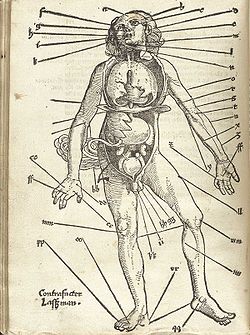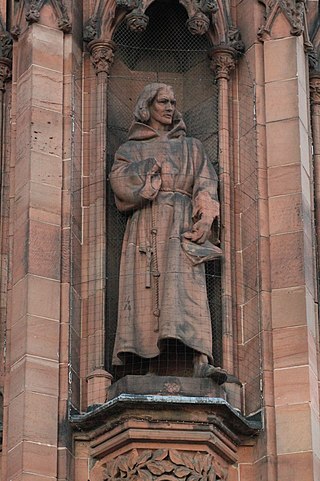
William Dunbar was a Scottish makar, or court poet, active in the late fifteenth and early sixteenth centuries. He was closely associated with the court of King James IV and produced a large body of work in Scots distinguished by its great variation in themes and literary styles. He was probably a native of East Lothian, as assumed from a satirical reference in The Flyting of Dumbar and Kennedie. His surname is also spelt Dumbar.
Middle Scots was the Anglic language of Lowland Scotland in the period from 1450 to 1700. By the end of the 15th century, its phonology, orthography, accidence, syntax and vocabulary had diverged markedly from Early Scots, which was virtually indistinguishable from early Northumbrian Middle English. Subsequently, the orthography of Middle Scots differed from that of the emerging Early Modern English standard that was being used in England. Middle Scots was fairly uniform throughout its many texts, albeit with some variation due to the use of Romance forms in translations from Latin or French, turns of phrases and grammar in recensions of southern texts influenced by southern forms, misunderstandings and mistakes made by foreign printers.

A Satire of the Three Estates, is a satirical morality play in Middle Scots, written by makar Sir David Lyndsay. The complete play was first performed outside in the playing field at Cupar, Fife in June 1552 during the Midsummer holiday, where the action took place under Castle Hill. It was subsequently performed in Edinburgh, also outdoors, in 1554. The full text was first printed in 1602 and extracts were copied into the Bannatyne Manuscript. The Satire is an attack on the Three Estates represented in the Parliament of Scotland – the clergy, lords and burgh representatives, symbolised by the characters Spiritualitie, Temporalitie and Merchant. The clergy come in for the strongest criticism. The work portrays the social tensions present at this pivotal moment in Scottish history.

Tungland or Tongland Abbey was a Premonstratensian monastic community located in Tongland in the historical county of Kirkcudbrightshire in Dumfries and Galloway, Scotland. It was probably founded circa 1218 by Alan, Lord of Galloway, although the church of Tongland had previously been granted to Holyrood Abbey by his grandfather Uchtred in the early 1160s. Few of its early abbots are known and its history is more generally covered by a cloud of obscurity.
John Stewart of Baldynneis was a writer and courtier at the Scottish Court. He was one of the Castalian Band grouped around James VI.
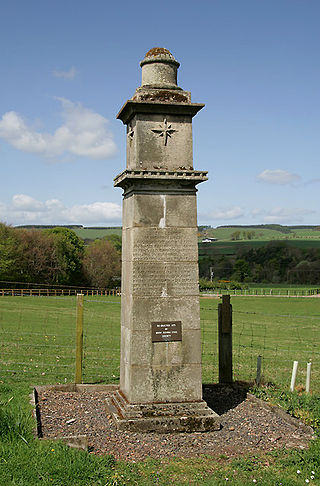
Antoine d'Arcy, sieur de la Bastie-sur-Meylan and of Lissieu, was a French nobleman involved in the government of Scotland.
William Stewart was a Scottish poet working in the first half of the 16th century.
John Damian de Falcuis was an Italian at the court of James IV of Scotland. His attempts at medicine, alchemy, flying, and his advancement by the king encouraged a satirical attack by the poet William Dunbar.
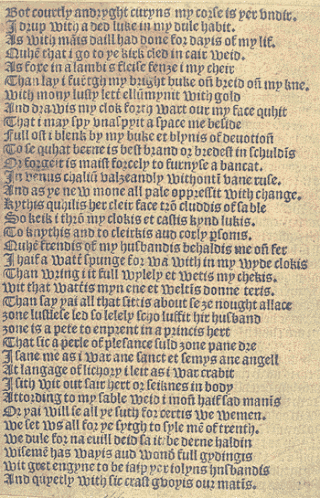
The Tua Mariit Wemen and the Wedo or The Tretis Of The Twa Mariit Wemen and the Wedo is a narrative poem in Scots by the makar William Dunbar.

On His Heid-Ake, also referred to as The Headache and My Heid Did Yak Yesternicht, is a brief poem in Scots by William Dunbar composed at an unknown date.

"Of Ane Blak-Moir" is a short poem in Scots by William Dunbar.

"The Twa Cummeris", also rendered as "The Twa Cumeris", is a short humorous poem in Scots written at an unknown date by William Dunbar

Remonstrance to the King is a Scots poem of William Dunbar composed in the early sixteenth century. The Remonstrance is one of Dunbar's many appeals to his patron James IV of Scotland asking for personal advancement. In this particular case, the unseemly personal pleading is combined with more dignified subject matter; lavish praise and pointed criticism of the King's court is delivered in an open manner.

The Chepman and Myllar Press was the first printing press to be established in Scotland.
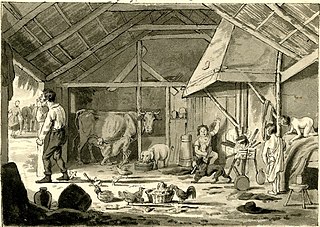
"The Wife of Auchtermuchty" is a Scots poem of the fifteenth or sixteenth centuries.

The Thrissil and the Rois is a Scots poem composed by William Dunbar to mark the wedding, in August 1503, of King James IV of Scotland to Princess Margaret Tudor of England.

The Petition Of The Gray Horse, Auld Dunbar is an appeal by the Scots poet William Dunbar to his patron King James IV of Scotland in which he requests a new gown to mark Christmas.

Of James Dog or, more fully, Of James Dog, Kepair of the Quenis Wardrop is a poem of William Dunbar in which the poet complains to Queen Margaret Tudor of Scotland about the keeper of her wardrobe, James Dog.

He Is Na Dog, He Is A Lam is a poem by William Dunbar addressed to Queen Margaret Tudor of Scotland.
Ane Dance in the Quenis Chalmer or A dance in the Queen's chamber is a humorous or satiric Scots poem by William Dunbar.

